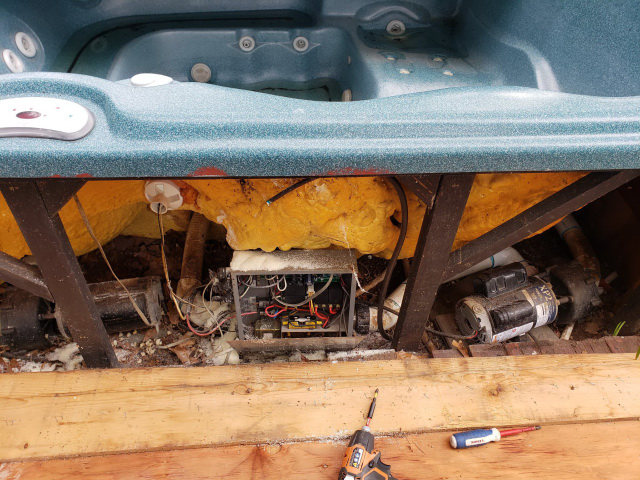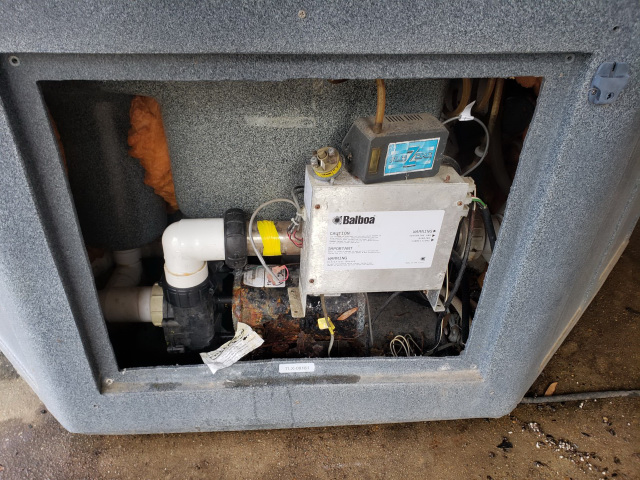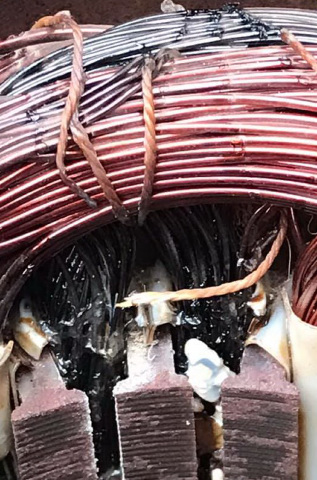Nothing is as frustrating as a circuit breaker that keeps tripping whenever you turn on your hot tub. Imagine you had a really long day, and you just want to enjoy some R&R after a hard day’s work. You grab a cold drink, turn on some tunes, and get ready to dive into paradise. But before you even dip your toes in, the power goes out on your tub, turning your tub of soothing bliss into a glorified kiddie pool.
A hot tub or spa GFCI circuit breaker can trip or switch off for many reasons. Here’s the most common reason hot tub breakers trips:
- Faulty GFCI
- Moisture or Water Exposure
- Faulty Water Heater
- Flooded Ozonator or Air Blower
- Too Many Accessories
- Faulty Pump
- Loose Plugs, Terminals, or Damaged Wiring
You might be wondering how you can figure out what’s causing your hot tub GFCI circuit breaker to go off in the first place. Well, chances are that the reason is listed below, along with a way to confirm, fix, and prevent it from happening again!

Most Common Reasons for Hot Tub Circuit Breaker Tripping (And How to Fix Them)
Normally, if your circuit breaker or GFCI (Ground Fault Circuit Interrupter) trips, it is protecting you from an unexpected power surge.
But if it keeps switching off on a consistent basis, there’s something wrong with your hot tub or hot tub circuit. Unfortunately, this isn’t a problem that will resolve itself. The good news is, that once you can identify the problem, you can fix the problem regardless of its initial cause.
As a former Electronics Technician and Electrician, I will give you the common reasons why your GFCI hot tub breaker is tripping.
1. Faulty GFCI
Let’s start with the simplest thing to check first.
Often, the root reason that a circuit breaker keeps tripping is as simple as a worn-out breaker. The GFCI itself may degrade over time, but in most cases, the wear & tear comes from constant power surges. In rare cases, the cause can also be a lightning strike to the breaker box.
How to Identify a Worn-Out Circuit Breaker?
This will depend on the type of GFCI you have.
For receptacle or portable GFCIs, testing your GFCI is a very straightforward process. Unplug anything plugged into the outlet. Just disconnect everything from the box and try resetting the GFCI. If the circuit breaker still trips at this point, you’ve got a bad GFCI on your hands.
If you have a GFCI that’s mounted on the DIN rail in your breaker box, then you can only partially test it. Unplug your hot tub and reset the breaker. If it doesn’t trip, it’s the hot tub.
If it still trips, it could be the GFCI itself or the wiring or receptacles between the panel and the GFCI. You’ll need an electrician to help with this.
How to Fix a Worn-out GFCI?
The only solution here is a replacement circuit breaker. Depending on your required capacity, it shouldn’t set you back more than $30-$150.
2) Exposure to Water/Moisture
Water can either cause an immediate issue or trip the breaker. That is, if it finds its way into the hot tub motor housing, control panel, or even plugs or terminals, the water will cause a short circuit which in turn will trip the GFCI.
For obvious reasons, water exposure does not mix well with electrical circuits. If there’s enough moisture – and it only takes a few drops in the right spot – the GFCI is actually doing its job by breaking the circuit.
That’s good news since it means there may not be any real damage to fix.
If there is prolonged exposure to moisture but no short circuit, it will cause the components to oxidize and corrode. Eventually, this could cause a pool connection and “arcing”. Arcing can cause a GFCI circuit breaker to overload and trip too.
How to Identify Water Exposure?
First thing first – for safety’s sake, switch the power off at the GFCI. Now simply open up the inspection panel on the side of your hot tub. Use a flashlight to identify any visible puddling, condensation, or rust spots.
How to Solve the Moisture Causing Your Circuit Breaker to Trip?
For any drops or puddling, you can just use paper towels to dab them dry. If condensation is present, you will need to air dry it. The recommended method is using a fan or dehumidifier to slowly get rid of all the moisture. However, if you’re in a hurry, a hair dryer will get the job done in a fraction of the time.
How to Prevent Water Exposure?
Most leaks in hot tubs can be found where the pipes and lines join together. It may be as simple as ensuring the hose connections are tight and fitted correctly. Or you may need to replace old hoses.
Another place water leaks from is the impeller. Check around the pump shaft for corrosion. Corrosion is a sign of water leaking.
Check that the unions on the water heater and pump are tight too. Sometimes the o-rings inside the unions can be faulty too.

3. Faulty Water Heater
Even if you maintain your hot tub 100% correctly, it’s only a matter of time before the heating element wears out or breaks down. It is basically a coil inside a metal tube.
Over time, the chlorinated hot tub water corrodes the metal causing a fault in the heater of complete failure.
Element Burn-Out
The element in a hot tub heater will burn out if the element powers on before sufficient cooling water passes through it. Likewise, the heating and cooling action over time can slowly deform the element. A burnt-out element or damaged element can cause the GFCI to trip.
Defective or Shorted Water Heater
It’s not always possible to pin down the exact cause of a shorted/faulty water heater. The internal wiring of the heater over time can go short-circuit or become high in resistance. Either of these faults will definitely cause the GFCI to trip.
How to Identify a Faulty Heating Element?
First, switch off the power at the breaker. Then take the inspection panel off your hot tub. The water heater is usually a stainless steel cylinder.
Inspect the wiring nearby for any melting if it’s melted that’s a problem.
Meanwhile, if you’re looking to diagnose a heating element that is short-circuited, simply unplug the heater altogether. If the GFCI doesn’t trip without the heater plugged in, you’ve found the problem.
You can also use a multimeter to check for a short circuit or high resistance on the heater element.
How to Fix a Bad Heater?
You’ll need to replace the water heater or if you’re lucky, you can buy a replacement heating element for less than $50.
4. Flooded Ozonator or Air Blower
Sure, the air blower is just a common accessory, whereas the Ozonator keeps the water clean and free of contaminants. But in both cases, if any water is present inside the units, the GFCI will trip.
This happens when water flows back into the blower or Ozonator due to a faulty check valve.
How to Identify a Flooded Air Blower/Ozonator?
Unplug each device individually and try flipping the breaker. Does unplugging one of the devices allow the rest of your hot tub setup to stay on? Then you’ve found your culprit.
How to Get Water Out of Your Ozonator or Air Blower?
The first step is draining the tub. Then, you’ll need to replace the bad valve that caused the flooding (It will either be a control valve or a non-return valve). If an air blower is too wet to dry out, you may have to replace it as well.
How to Prevent Flooding of Components?
There’s no way to predict when a valve will break down. All you can do is choose quality equipment and watch the water level to make sure the tub isn’t overfilled. If the water level rises above the air blower loop, flooding is practically guaranteed.
5. Too Many Accessories
If you’ve tested all the main electrical components of your hot tub setup, the issue may be in the smaller accessories. You may have overloaded the circuit and the accessories may be too much for the GFCI.
Even though they don’t necessarily use as much power as a water heater or air blower, the amount of power the accessories use does add up and is a fairly common cause of circuit breakers tripping.
Electrical accessories typically include all of the below:
- Automatic cover lifter;
- Towel warmers;
- Bottom lighting;
- Mini-fountain;
- Speaker system.
How to Identify an Accessory Causing GFCI to Trip?
This step will be identical to diagnosing any other electrical component. Unplug each accessory one by one to see if the circuit breaker will stop tripping. If you find the breaker doesn’t trip after unplugging a particular accessory, it’s likely the accessory is faulty.
If no single device is the root cause, try unplugging some or all the accessories. If you see that the GFCI breaker doesn’t trip or cut out, you have likely overloaded the circuit.
Either use another outlet to plug in your accessories, leave some unplugged or get an upgraded or additional power circuit put in.
6. Faulty Pump Motor
The pump in your hot tub can also cause the circuit breaker to trip repeatably. The pump is made of two components:
- Impeller
- Motor
Impeller
The impeller is located inside a housing next to the pump motor. It’s what moves the water through your hot tub.
If the impeller has a blockage in it or the bearings are ceased or tight, there will be an extra load on the motor which can cause the GFCI to trip.
Motor
There are several faults that can occur with a hot tub pump. This can include a bad capacitor, burnt-out windings, or ceased bearings. All of these problems are enough to cause the GFCI circuit breaker to trip.

How to Fix a Bad Pump
In most cases, if the pump is the cause of the problem, it will need to be replaced. If it’s the run or start capacitor causing the problem, this can be replaced.
Further Reading: 6 Signs a Pool Pump Capacitor Is Bad (and how to test)
7. Loose Plugs, Terminals, or Damaged Wiring
All electrical connections need to be tight and secure. A loose plug or loose terminal screw is enough to cause arcing. As a result, the circuit breaker will trip.
In addition to loose terminals and plugs, you want to look out for damaged wiring. Sometimes wires melt and then touch together. This causes a short circuit which will mean the breaker will trip repeatedly.
Also, look out for rodent damage. Rodents like to chew on things and there have been many cases of rodents chewing or damaging electrical cables.
How to Fix Wiring Issues
Firstly, make sure everything is switched off at the breaker. You want to make sure all electrical plugs inside your hot tub are pushed tightly together.
You may also check that the terminals for the wires supplying the control board and motors are tight. You must make sure the power is off though before doing this or you risk electrocution and death. Do this by checking with a multimeter first or getting an electrician if you don’t know what you’re doing.
Related Reading: What Gauge or Thickness Wire Does a Pool Pump Need?
GFCI Circuit Breaker Trips Randomly
Here are some of the things that can cause a GFCI circuit breaker to trip randomly or intermittently:
- Moisture – can be in control panels, and plugs. Look inside the control panel for signs of moisture and also for water leaks in your tub.
- Worn contacts or loose terminals – all plugs and terminals should be tight.
- Corrosion – check plugs and terminals for corrosion.
- Faulty control panel – the control panel itself could be faulty.
- Faulty water heater – when water heaters are on the way out, they can cause the GFCI breaker to randomly trip.
Related Reading: How to Fix Pool Pump Tripping Circuit Breaker (Repeatedly)



